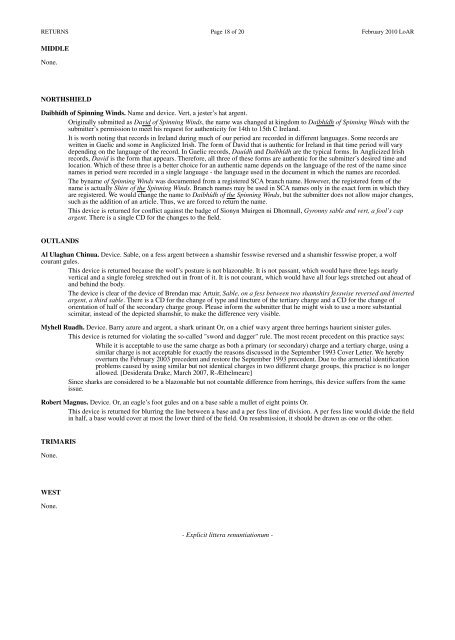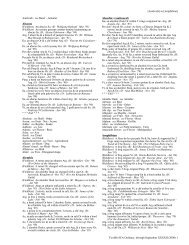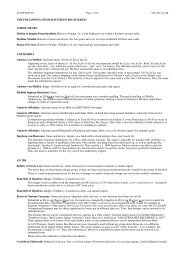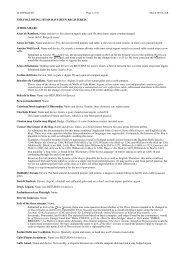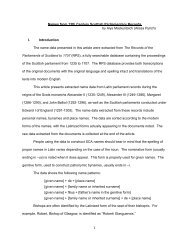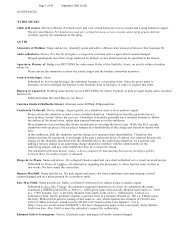You also want an ePaper? Increase the reach of your titles
YUMPU automatically turns print PDFs into web optimized ePapers that Google loves.
RETURNS Page 18 of 20 February 2010 LoAR<br />
MIDDLE<br />
None.<br />
NORTHSHIELD<br />
Daibhídh of Sp<strong>in</strong>n<strong>in</strong>g W<strong>in</strong>ds. Name and device. Vert, a jester’s hat argent.<br />
Orig<strong>in</strong>ally submitted as David of Sp<strong>in</strong>n<strong>in</strong>g W<strong>in</strong>ds, the name was changed at k<strong>in</strong>gdom to Daibhídh of Sp<strong>in</strong>n<strong>in</strong>g W<strong>in</strong>ds with the<br />
submitter’s permission to meet his request for authenticity for 14th to 15th C Ireland.<br />
It is worth not<strong>in</strong>g that records <strong>in</strong> Ireland dur<strong>in</strong>g much of our period are recorded <strong>in</strong> different languages. Some records are<br />
written <strong>in</strong> Gaelic and some <strong>in</strong> Anglicized Irish. The form of David that is authentic for Ireland <strong>in</strong> that time period will vary<br />
depend<strong>in</strong>g on the language of the record. In Gaelic records, Dauídh and Daibhídh are the typical forms. In Anglicized Irish<br />
records, David is the form that appears. Therefore, all three of these forms are authentic for the submitter’s desired time and<br />
location. Which of these three is a better choice for an authentic name depends on the language of the rest of the name s<strong>in</strong>ce<br />
names <strong>in</strong> period were recorded <strong>in</strong> a s<strong>in</strong>gle language - the language used <strong>in</strong> the document <strong>in</strong> which the names are recorded.<br />
The byname of Sp<strong>in</strong>n<strong>in</strong>g W<strong>in</strong>ds was documented from a registered <strong>SCA</strong> branch name. However, the registered form of the<br />
name is actually Shire of the Sp<strong>in</strong>n<strong>in</strong>g W<strong>in</strong>ds. Branch names may be used <strong>in</strong> <strong>SCA</strong> names only <strong>in</strong> the exact form <strong>in</strong> which they<br />
are registered. We would change the name to Daibhídh of the Sp<strong>in</strong>n<strong>in</strong>g W<strong>in</strong>ds, but the submitter does not allow major changes,<br />
such as the addition of an article. Thus, we are forced to return the name.<br />
This device is returned for conflict aga<strong>in</strong>st the badge of Sionyn Muirgen ni Dhomnall, Gyronny sable and vert, a fool’s cap<br />
argent. There is a s<strong>in</strong>gle CD for the changes to the field.<br />
OUTLANDS<br />
Al Ulaghan Ch<strong>in</strong>ua. Device. Sable, on a fess argent between a shamshir fesswise reversed and a shamshir fesswise proper, a wolf<br />
courant gules.<br />
This device is returned because the wolf’s posture is not blazonable. It is not passant, which would have three legs nearly<br />
vertical and a s<strong>in</strong>gle foreleg stretched out <strong>in</strong> front of it. It is not courant, which would have all four legs stretched out ahead of<br />
and beh<strong>in</strong>d the body.<br />
The device is clear of the device of Brendan mac Artuir, Sable, on a fess between two shamshirs fesswise reversed and <strong>in</strong>verted<br />
argent, a third sable. There is a CD for the change of type and t<strong>in</strong>cture of the tertiary charge and a CD for the change of<br />
orientation of half of the secondary charge group. Please <strong>in</strong>form the submitter that he might wish to use a more substantial<br />
scimitar, <strong>in</strong>stead of the depicted shamshir, to make the difference very visible.<br />
Myhell Ruadh. Device. Barry azure and argent, a shark ur<strong>in</strong>ant Or, on a chief wavy argent three herr<strong>in</strong>gs haurient s<strong>in</strong>ister gules.<br />
This device is returned for violat<strong>in</strong>g the so-called "sword and dagger" rule. The most recent precedent on this practice says:<br />
While it is acceptable to use the same charge as both a primary (or secondary) charge and a tertiary charge, us<strong>in</strong>g a<br />
similar charge is not acceptable for exactly the reasons discussed <strong>in</strong> the September 1993 Cover Letter. We hereby<br />
overturn the February 2003 precedent and restore the September 1993 precedent. Due to the armorial identification<br />
problems caused by us<strong>in</strong>g similar but not identical charges <strong>in</strong> two different charge groups, this practice is no longer<br />
allowed. [Desiderata Drake, March 2007, R-Æthelmearc]<br />
S<strong>in</strong>ce sharks are considered to be a blazonable but not countable difference from herr<strong>in</strong>gs, this device suffers from the same<br />
issue.<br />
Robert Magnus. Device. Or, an eagle’s foot gules and on a base sable a mullet of eight po<strong>in</strong>ts Or.<br />
This device is returned for blurr<strong>in</strong>g the l<strong>in</strong>e between a base and a per fess l<strong>in</strong>e of division. A per fess l<strong>in</strong>e would divide the field<br />
<strong>in</strong> half, a base would cover at most the lower third of the field. On resubmission, it should be drawn as one or the other.<br />
TRIMARIS<br />
None.<br />
WEST<br />
None.<br />
- Explicit littera renuntiationum -


